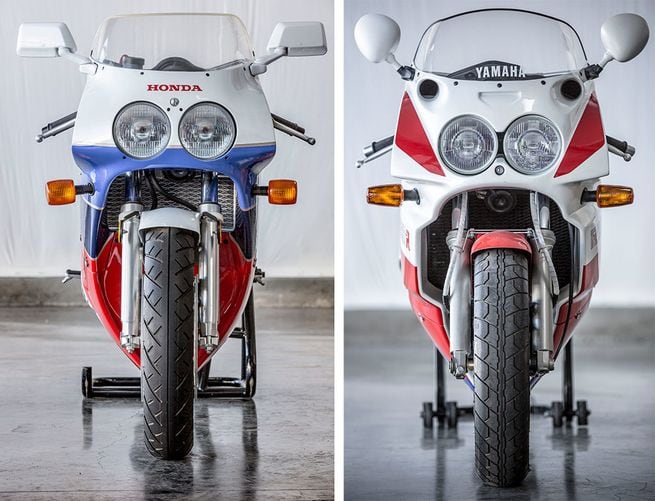The RC30 is peak Honda. It was never the everyman's superbike (it was the opposite, really), but the symbiosis of all its related parts made it incredibly refined, an adjective so often applied to the most Honda-y of Hondas. Lighter than its plebeian competition, the RC30 (or VFR750R in Europe and Asia) was hand-built by the boffins at HRC. Boasting titanium connecting rods, trick elf single-sider, and minuscule proportions, the RC30 won two WorldSBK championships right out of the box, thanks to the talent of Fred "The Flying Mullet" Merkel. Okay, that wasn't his actual nickname.
If you’re feeling a bit wound up, Honda’s RC30 promotional video from the period will surely calm you down. Piano music that sounds like it was lifted from the European soft jazz label ECM (whose motto is “the most beautiful sound next to silence,” says Wikipedia) opens as dudes in matching coveralls and green caps lovingly assemble the engine in what appears to be an anechoic chamber or something—an oddly sterile-looking environment for assembling a motorcycle.
Like watchmakers, the serious-looking HRC workers painstakingly (and very quietly) put together one of the most beautiful, lust-worthy machines to ever roll on two wheels. Who knew that the ca-chunk of pistons being pushed into their cylinders could sound so satisfying—or that precise manufacturing tolerances made for such soothing viewing?
Once the chaps stand back to admire their work, the film cuts to some nice slow-mo tandem action of RC30s on a track. Whenever I watch it, I just want to yell, “Honda, please make a V-4 superbike again!” but imagine the HRC guys will somehow shush me through the ether, like perturbable digital librarians.











/cloudfront-us-east-1.images.arcpublishing.com/octane/ZHPWZ3SV7XCUQYOGGIKY6ZKKNM.jpg)

/cloudfront-us-east-1.images.arcpublishing.com/octane/S35YGSEMEZB4BLTDJTSZPF4GLA.jpg)
/cloudfront-us-east-1.images.arcpublishing.com/octane/5UOT6HPX2JFMRJAX6EH45AR4MQ.jpg)
/cloudfront-us-east-1.images.arcpublishing.com/octane/OKWOJWAKP5EP3OACCRRWPCIX2Q.jpg)
/cloudfront-us-east-1.images.arcpublishing.com/octane/2WF3SCE3NFBQXLDNJM7KMXA45E.jpg)
/cloudfront-us-east-1.images.arcpublishing.com/octane/G4MG6OUCJNBSHIS2MVVOTPX65E.jpg)
/cloudfront-us-east-1.images.arcpublishing.com/octane/IIGGWFOTOJGB7DB6DGBXCCMTDY.jpg)
/cloudfront-us-east-1.images.arcpublishing.com/octane/QSTCM6AVEZA5JJBUXNIQ3DSOF4.jpg)
/cloudfront-us-east-1.images.arcpublishing.com/octane/U4I7G625B5DMLF2DVIJDFZVV6M.jpg)
/cloudfront-us-east-1.images.arcpublishing.com/octane/B6XD6LS6IVCQPIU6HXDJSM3FHY.jpg)
/cloudfront-us-east-1.images.arcpublishing.com/octane/ICL63FEDDRDTTMINYICCEYGMDA.jpg)
/cloudfront-us-east-1.images.arcpublishing.com/octane/FCGZHQXRBZFLBAPC5SDIQLVF4I.jpg)
/cloudfront-us-east-1.images.arcpublishing.com/octane/WNOB6LDOIFFHJKPSVIWDYUGOPM.jpg)

/cloudfront-us-east-1.images.arcpublishing.com/octane/X33NU3E525ECRHXLNUJN2FTRKI.jpg)
/cloudfront-us-east-1.images.arcpublishing.com/octane/6KKT5NNL2JAVBOXMZYS5ZO76YA.jpg)
/cloudfront-us-east-1.images.arcpublishing.com/octane/J5RKG5O455GMPGQRF2OG6LRT7A.jpg)
/cloudfront-us-east-1.images.arcpublishing.com/octane/GX2CIZKQVRH2TATDM26KFG2DAE.jpg)
/cloudfront-us-east-1.images.arcpublishing.com/octane/ZWIDYSAKQZHD5BHREMQILXJCGM.jpg)
/cloudfront-us-east-1.images.arcpublishing.com/octane/CYUHJZCTSJCH3MRAQEIKXK7SCQ.jpg)
/cloudfront-us-east-1.images.arcpublishing.com/octane/LKOFINY56FCXJCANJ5M7ZDQUBY.jpg)
/cloudfront-us-east-1.images.arcpublishing.com/octane/4NBPDACMWJH63JQYJVK3QRBDZI.jpg)
/cloudfront-us-east-1.images.arcpublishing.com/octane/KKHQHRR3FJGX7H2IPU6RALMWG4.jpg)

/cloudfront-us-east-1.images.arcpublishing.com/octane/5IOFS5JAE5FOXMNA23ZRAVVYUU.jpg)